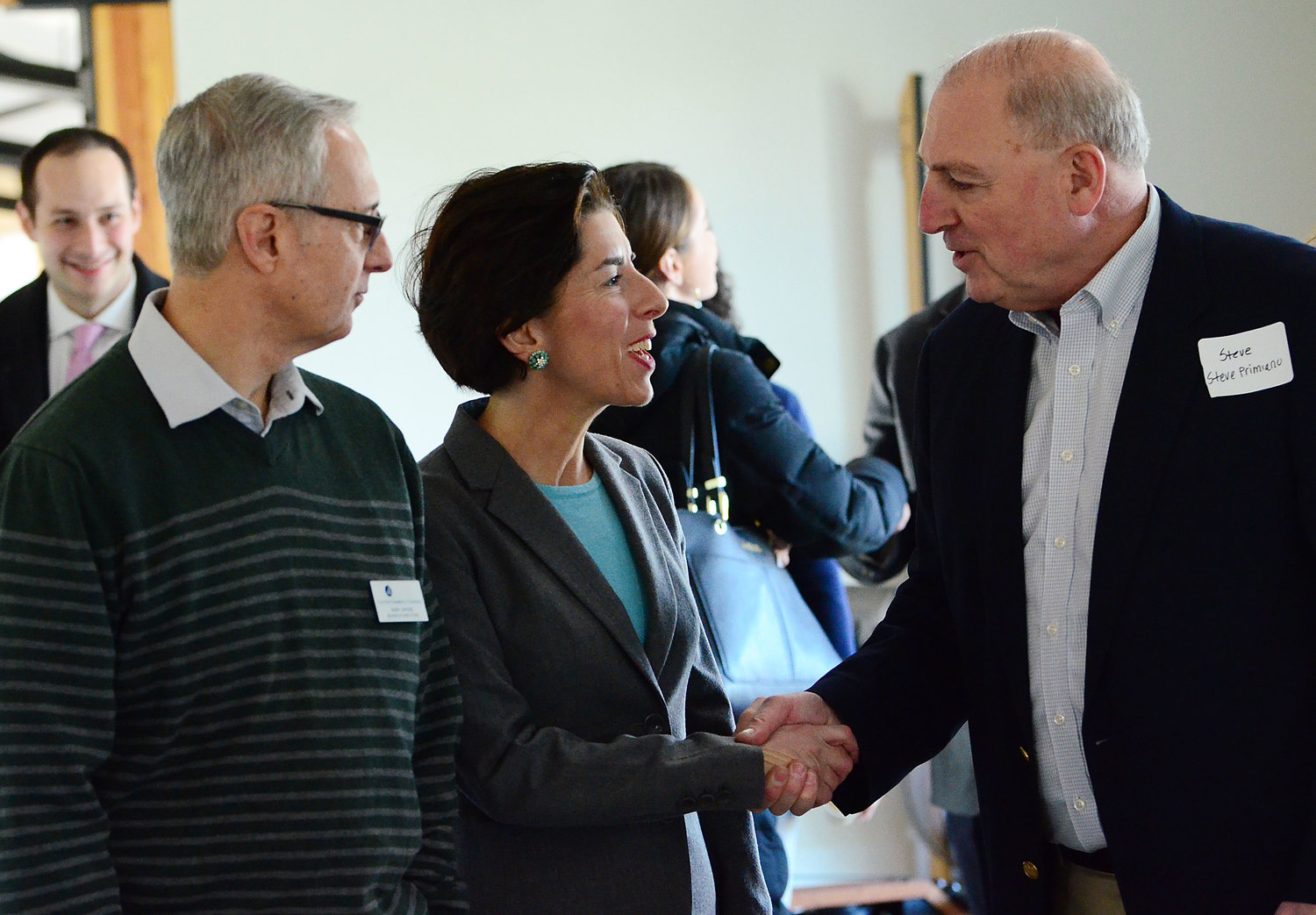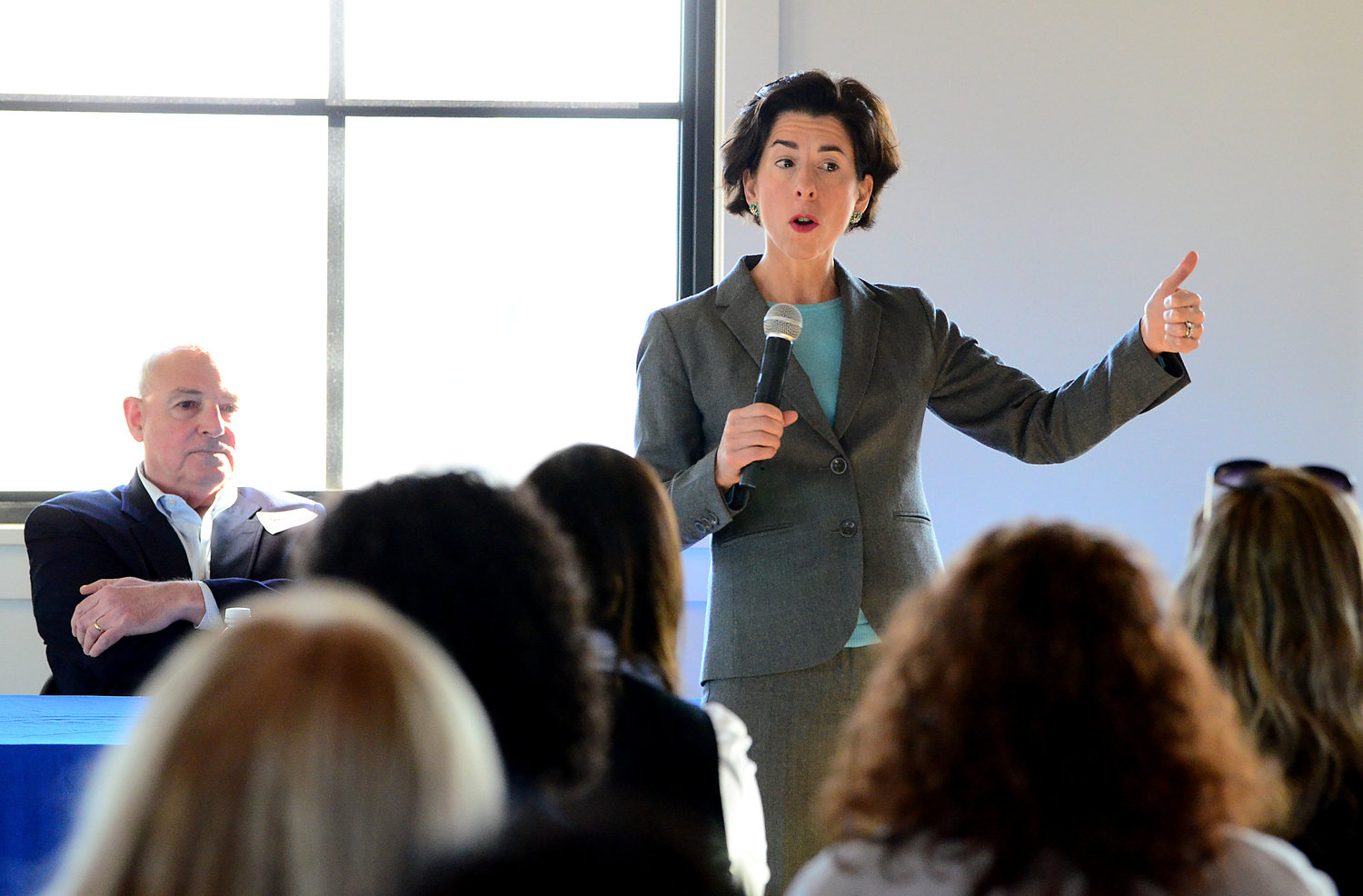- SATURDAY, APRIL 27, 2024
Gov. Raimondo takes the mic to talk jobs, skills and schools (Video)
Gov. Gina Raimondo talks passionately about jobs, job training and the future of education in Rhode Island
Gov. Gina Raimondo spent about an hour with a large gathering of the East Bay Chamber of Commerce last Friday, Jan. 31, in a wide-ranging dialogue that talked about tired schools, a growing economy, …
This item is available in full to subscribers.
Please log in to continue |
Register to post eventsIf you'd like to post an event to our calendar, you can create a free account by clicking here. Note that free accounts do not have access to our subscriber-only content. |
Day pass subscribers
Are you a day pass subscriber who needs to log in? Click here to continue.
Gov. Raimondo takes the mic to talk jobs, skills and schools (Video)
Gov. Gina Raimondo talks passionately about jobs, job training and the future of education in Rhode Island
Gov. Gina Raimondo spent about an hour with a large gathering of the East Bay Chamber of Commerce last Friday, Jan. 31, in a wide-ranging dialogue that talked about tired schools, a growing economy, teaching people to get jobs, and “upscaling” Rhode Island to surpass Massachusetts.
The governor boasted about her record in both jobs and education, backed those boasts with data, and challenged everyone in the room to ask what they can do to improve their community and their state. She said she “found religion” on the issue of teaching real-world job skills. She said the “free college” program at the Community College of Rhode Island is a big success. And she bragged about how Rhode Island is better than Massachusetts in some ways — and talked about why it must get better in other ways.
During the meeting, held inside a large, light-filled room at the new WaterRower plant on Metacom Avenue in Warren, Gov. Raimondo spoke for about 15 minutes about her three highest priorities —
“I’m working hard, and I am focused on making it easier and cheaper to do business, infrastructure, and job training and education,” she said — before responding to a couple dozen questions from the audience.
Following are snippets of the governor’s appearance, mostly in her own words.
Fixing the state’s economy
“At a high level, I feel like Rhode Island is headed in the right direction. We’re not where we need to be in every regard, but when I started as governor, we were in the dumps. In 2014, for 10 of the 12 months of 2014, Rhode Island had the highest unemployment rate in the country.
“The unemployment rate in the building trades the day after I was elected was about 26 percent. There were people who had been out of work for a year or two or three. And a lot of you here run small companies, you’re manufacturers, you know it was a struggle. You were letting people do work shares, cutting staff. Today, I don’t hear that so much. The unemployment rate in the building trades today is about 2 percent. So we’ve gone from more than 20 to 2 percent.
“And you can kind of feel it. It’s more than just statistics. Our wage growth was stronger than Massachusetts for the past few years. Our unemployment rate has dropped more than any state in the country.
“We’re fixing roads, fixing bridges, investing in our schools … We’ve kind of stopped the decline, and we’re heading in a new direction.
Reducing business regulation
“Before I got into politics and became treasurer, I ran my own business. So I know what’s it’s like. And whatever you’re doing, whether you’re making water rowers or building boxes, that’s what you want to be doing. You don’t want to be dealing with regulations and sitting on the phone with DBR, or whatever. You want to running your business.
“So since I’ve been governor, we’ve eliminated hundreds of regulations. We’re doing everything we can to make it easier. We’re putting permitting online. I’d like to see zoning more streamlined and online.
“I’ve cut unemployment insurance taxes three times. You’re going to see more cuts in your unemployment insurance taxes this year. I’ve cut the the small business tax three times … I’d frankly like to eliminate it if we can.”
Investing in infrastructure
“Every business, big or small, tells me we need better roads, better airports, better trains, fewer potholes, and to fix the sidewalks that are broken. And I agree, so we’re doing it. We’ve fixed more roads in the past year than ever in our state’s history. I know there’s a little traffic, and I’m sorry about that, but the traffic is temporary and the changes are permanent, or at least for 20 to 30 years.
“My top priority on infrastructure now is that I want to get a faster train to Boston,” she said. The current Amtrak train from Providence to Boston costs $30 each way. The governor said that’s too expensive for the average commuter.
“I want to get it to be 30 to 40 minutes to Boston, at the price of the MBTA. So I’m working on that.”
Investing in school buildings
“I spend a lot of time in public schools. The teachers are working hard. The students are working hard. The buildings are old. Mt. Hope has closed how many times in the past few years? Burst pipes … I went to a middle school in East Greenwich a year ago. I know it’s not in the East Bay, but the day before I arrived, the ceiling in the gym fell down. There were kids there, a few feet away … So we put a bond on the ballot for investing in schools. We’re going to do another one. So we’re working on that.”
Developing job skills
“Businesses I talk to all tell me it’s hard to find talent. Here’s the reality right now in Rhode Island. If you have skills, you can get a job. A decent job. But if you don’t, if all you have is a high school degree, you’re not going to get a high-paying job. That’s a brutal but real reality of the American economy right now.”
She told the audience how when she graduated from high school in 1989, a high school diploma could still open doors to decent jobs.
“By the way, I lived it. My Dad was in a carpool every morning with his buddies and they trotted off to Bulova Watch. Four or five guys, with their lunch bags, they all had a good job at that factory. His best friend was a custodian, another guy was a security guard, some guys worked on the line, my father had a job in the metallurgy department. Well that factory is gone, those thousands of jobs are gone, and that kind of carpool doesn’t exist today. You need a degree or credential past high school. Period. It is my top priority for Rhode Island.”
Rhode Island vs. Massachusetts
“People talk about Massachusetts — ‘Oh, it’s such a hot economy’ — It’s a hot economy because they have an educated workforce. Our corporate taxes are lower than Massachusetts’. Our restaurants are better. Our beaches are better. Our quality of life is better. The big difference between us and Massachusetts is the talent pool. And they have figured out how to create jobs out of their colleges and universities. So if I do nothing else as your governor, if I can upscale our population, it will supercharge this economy.”
An educated workforce
“This is what keeps me up at night. There are 115,000 Rhode Islanders who have a high school degree, some college, but there’s no degree past college. So you know what they’re doing? They’re working two or three minimum wage jobs. They’re working 70, 80 hours a week. And they’re poor.
“We’ve got to do better by them. They need skills. So I’ve made community college free — two years for everybody. Let me tell you something, that’s a few million dollars a year. It’s half of a drop in the bucket of a $10 billion budget. You know what’s happened since we’ve launched that promise program? We have tripled the graduation rate of CCRI. We have more students than ever getting these degrees.”
Training for real jobs
“When I took over as governor of the state, the strategy was what I refer to as ‘train and pray.’ Train people and pray they get a job. It’s a totally ineffective use of your tax dollars.
“Now, we do ‘train and place.’ They’re all getting jobs. Because what we do is, we come to businesses first. We go to the business, and we say, ‘What do you need? Who are you hiring? Tell us what to teach them.’ And then we teach them, and we serve them up for you to hire.
“We have trained and placed more than 7,000 Rhode Islanders in the past two years. That is real. That is a lot of jobs … I got religion on this one, because if people have skills, they will have opportunities, and your businesses will grow.”
Teaching financial literacy
“It’s important and we don’t do a good enough job … We’re trying to make it almost a required course in high schools, and I support moving in that direction.
“Here’s my general view on education, as a governor, as a businesswoman, and as a mother. We need to teach skills that are relevant. These kids need to come out of school with relevant skills. And financial literacy is relevant. The thing I worry about is debt. When we were in school, it was about balancing a checkbook. Nobody uses a checkbook anymore. But no one knows about the dangers of debt, especially student loans.”
On colleges and debt
“I tell people do not go to a four-year college unless you know how much it costs, why you want to go, and why you think you need it. Fifty percent of students in America who start college, drop out. You know what that means? They drop out with no degree, a pile of debt, and no good job. That’s a disaster.
“So, yes, I’m a huge believer in career and technical education. Welding, plumbing, cyber-technology. You do not need a four-year college degree to become a cyber-technician. We are actually affiliating with high schools.
“CVS has kind of adopted Woonsocket High School, with CCRI. You go to high school for five years, you get an associate’s degree from CCRI, a high school diploma, and a job as a pharmacy tech with CVS. Fifty-grand a year plus benefits is a good beginning job.”
Teaching technology
“These technology skills, computer skills are important in business today, and we have to teach kids when they’re young, but the problem is, we have to train the teachers first.
“When I became governor in 2014, I just asked, how many students in Rhode Island took the AP Computer Science test last year. Can anyone guess? It’s 42 — 42 students in all our public schools took the AP Computer Science test. Twelve were girls, and there were no kids of color. That’s a crisis, in my opinion.
“So we put forth a big initiative. We partnered with Microsoft. We partnered with URI. We partnered with Brown. And we’re making it so that, in every school, in every grade, these kids are learning some digital skills. And like we said, the trick is to train the teachers.
“I just got the data yesterday. Last year, 1,000 students took Computer Science and got college credit for it in high school. So in a few years we went from 42 to 1,000, and I want to get that a little higher.”
On National Grid
“I’ll be honest with you. National Grid is tough. Unfortunately, they don’t work for me. I’m actually trying to get some legislation to put some teeth into the way we regulate National Grid, so we can fine them for poor behavior. National Grid operates in three states. Here, Massachusetts and New York. Those other two states have teeth in the way they regulate Grid.”
On spending and taxes
“I’ve been cutting taxes, and I’m going to continue cutting taxes, because I know you’re burdened. But we also have to balance it, to make some investments, so we have a well-educated workforce, we have good roads and bridges … Here’s the thing — the biggest piece of Rhode Island’s budget is Medicare. It’s a billion dollars a year. And I’ve been working real hard to keep cutting and keeping an eye on those expenses. Because we can’t live beyond our means."
How to fix Providence schools
“The schools are a disaster, and it’s because of neglect. So I decided to do something no governor has ever done, which is to take over the Providence schools … It’s going to have to be wholesale changes. It starts with high standards. We’ve got to hold all kids to high standards. We have to believe that every kid can learn. Even the poor ones. Even the not-white ones. High standards for everyone.
“But we need a consistent curriculum, which has never happened. You go into these schools. You’ve got two second-grade classrooms, and they’re learning different things. More teachers. Less absenteeism. More teacher training. More teacher accountability. More career and technical education.
“And some of these schools, in their physical condition, you cannot learn. Honestly, shame on all of us, including me, for not knowing how bad they were. Now that I’m in it … you turn the tap water on, it’s brown. It’s freezing, the pipes burst. There are bats in classrooms. So we’ve got to rebuild schools. And the money is there to do it.
“Let me tell you another thing. It’s not because they don’t have enough money. We spend an awful lot of money in Providence schools, per pupil. Actually about as much as Boston. It’s doing a better job with how we spend the money … This is probably a 10-year effort, but I expect results every year, and I am on it. I am now on it. Because we are letting our teachers down, our kids down, and our economy down.”
On a longer school day
Dr. Jonathan Brice, superintendent of the Bristol Warren Regional School District, asked a question that drew a loud round of applause. Talking about all the things they’d like to add to their schools, he said a constant problem is time: “I think the issue every superintendent and every principal in this state runs into is, do we have enough time in the school day? If one district does it, there will be pushback, including the unions. But if we did something statewide, it gives us all enough cover where we could expand the school day and fit all these new programs.”
Gov. Raimondo agreed with Dr. Brice, but posed a different challenge.
“Here’s all I’m going to say, and I want everyone to think about it, including me. We haven’t really changed the way we teach, in decades. Think about when you went to school. Twenty to thirty kids in a classroom. The bell rings. The teacher talks to you.
“Seventy years later, you walk into the classroom, it’s the same kind of deal. The school day length hasn’t changed. The bell still rings. The buildings are pretty much the same.
“Imagine if you ran your business that same way — with no change. You’d be out of business. So my view is, and by the way you’re right, you will face resistance. Fight through the resistance. These kids have to be educated to get a job in 2020 and 2030. Not in 1955, when it was a short school day, and everybody was being trained to follow the bell, because that’s what you wanted.
“Come on, modernize. If that means a longer school day, do it. If that means getting rid of something, do it.”
Praise for the East Bay
“When I walked in, I was chatting with a few people, and I told them, I am so impressed with the East Bay community, and the way that you come together as a community to support one another, and to get things done.
“I go all over the place. Obviously. Providence, Cranston, Warwick, East Providence, Newport. You have something special in the East Bay. And I don’t say that everywhere I go. When you walk down the main streets in Warren, Bristol, you hear small businesses say all the things that they’re doing to help other small businesses. Your town manager is constantly on me to support different things, which is a good thing. Like right down to the detail of, “Governor, why is this sidewalk on this street not fixed yet?” Which is her job, and that’s a good thing.
“Never underestimate what it means when you come together and you support one another. Because I’ve seen the difference in your communities, and it’s very impressive.”
Other items that may interest you











